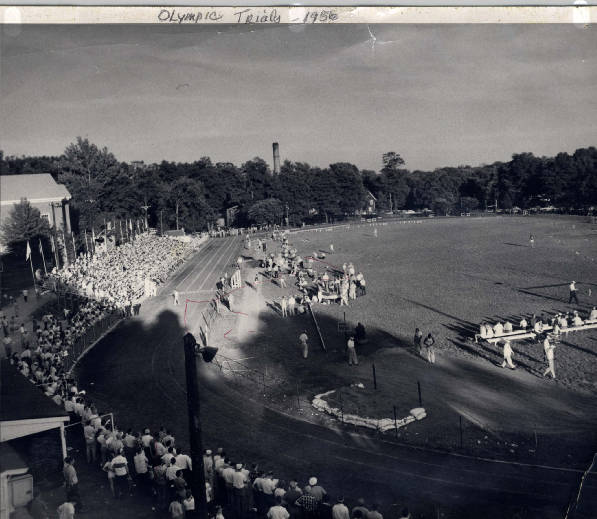by Tim Tuttle
Rafer Johnson, Milt Campbell and Bob Richards are probably the three greatest athletes to ever set foot on campus at Wabash College and they were there together 50 years ago.
They competed in the AAU national championship for the three decathlon positions which would represent the USA in the 1956 Olympics at Melbourne, Australia, 50 years ago this month.
Johnson, a 20-year-old from UCLA, won with 7,754 points, just short of his world record of 7,983. Campbell, a former Indiana University star, was second with 7,555 and Richards, already an Olympic champion in the pole vault, third with 7,054.
 Johnson had initially set the world record in 1955 in only his fourth decathlon, a grueling 10-event competition that requires power, speed and endurance. The Olympic champion in the event is regarded as the world's greatest athlete.
Johnson had initially set the world record in 1955 in only his fourth decathlon, a grueling 10-event competition that requires power, speed and endurance. The Olympic champion in the event is regarded as the world's greatest athlete.
Campbell had made the 1952 Olympic team in the decathlon as a high school senior and finished second in the Games at Helsinki, Finland, to the great Bob Mathias.
By 1956, Richards had already been to two Olympics in the pole vault. He won the gold at Helsinki and the bronze in 1948 in London. Now 30-years-old, Richards had decided to expand into the decathlon.
There were 35 more entrants, all outstanding athletes, at Wabash to try to knock off one of them.
Johnson was the leader with 4,639 points and Campbell second with 4,387 after the first day. Richards was seventh with 3,769, but the pole vault was ahead.
Johnson won 100-meters in 10.6 seconds, the long jump at 23-feet, 2 1/2-inches and tied for first in the 400 in 47.9, was third in the shot put at 49-8 3/4ths and was ninth in the high jump at 6-1. Johnson's deadlock with Aubrey Lewis of Notre Dame, where he also played halfback, was the fastest time ever run in a decathlon.
Campbell tied with Lewis for second in the 100 at 10.7, tied with Richards for second in the long jump at 22-8 1/2, was fifth in the shot put at 46-4 3/4, tied for fourth with Dave Norton in the high jump at 6-3 and was third in the 400 in 49.2.
On the second day, before a capacity crowd of 4,200 at Ingalls Field, Richards pole vaulted a decathlon record 15-1/8 on his third attempt to thrill the crowd. He had been the second vaulter to clear 15-0 previously, but had failed in his attempts to do it in Crawfordsville during a decathlon meet in 1955. Richards earned a whopping 1,122 points in the pole vault.
Campbell made a run at Johnson by winning the 110 high hurdles, his best event, in 14.1, also a decathlon record. Johnson was third in the event in 14.4 and Richards eighth at 15.6.
Johnson's prowess in the field events was decisive in the battle with Campbell. Johnson won the discus in 149-5 and was third in the Javelin in 182-4 1/2 in the javelin. Campbell was fifth in the discus at 142-1 and eighth in the javelin in 170-6. Campbell tied for the sixth in the pole vault at 12-0 and Johnson was eighth at 11-5 3/4. Neither athlete was in the top 10 in the final event, the 1,500.
Richards also was sixth in the discus at 135-7 1/2, eighth in the high hurdles at 15.6 and 10th in the 1,500 in 4:55.8. He was out of the top 10 in the javelin.
It was the first decathlon in history that had three over 7,000.
Campbell went on to become the Olympic champion at Melbourne with 7,708. In 1957, he set the world record in the 120-yard high hurdles in 13.40. After graduating from Indiana in 1957, Campbell played for the Cleveland Browns of the NFL and Montreal of the Canadian Football League. He's a member of the USA Olympic and Track and Field Halls of Fame.
Johnson was slowed by a knee injury in the 1956 Games and still won the silver in the decathlon. He also had qualified for the Games in the long jump, but withdrew because of the knee injury.
Johnson never lost another decathlon after the 1956 Games. He won three national AAU championships and the 1960 Olympic championship at Rome. Johnson won the Sullivan Award as the nation's top amateur athlete in 1960. He retired from competition and went on to become a successful actor and businessman.
Richards, an ordained minister, was 13th in the decathlon in the 1956 Games, but won his second gold medal in the pole vault. The Rev. Bob Richards may be most famous, though, for being the first athlete to be on the front of a Wheaties box in 1958. He's a member of the USA Olympic and Track and Field Halls of Fame.
Tuttle is the sports editor for The Paper of Montgomery County.
Photo: It was standing room only at Wabash during the 1956 US Olympic Decathlon Trials. Three of the greats of the sport --- Rafer Johnson, Milt Campbell, and Bob Richards --- competed in the ten events held on the Wabash College campus.
For more information see: